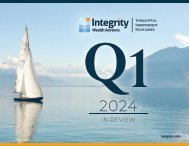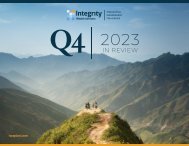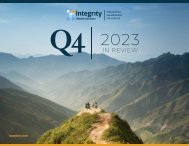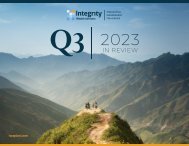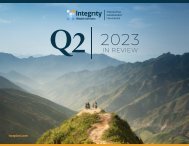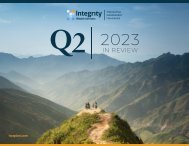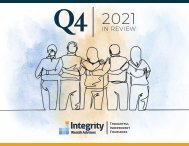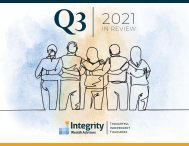2023 Q1 In Review - Integrity Wealth Advisors, Ventura & Ojai, California
You also want an ePaper? Increase the reach of your titles
YUMPU automatically turns print PDFs into web optimized ePapers that Google loves.
iwaplan.com<br />
<strong>Q1</strong> <strong>2023</strong><br />
IN REVIEW
TOTAL RETURN <strong>2023</strong> <strong>Q1</strong> + NEWSWORTHY EVENTS<br />
10%<br />
January 8 – China<br />
reopens borders in<br />
final farewell to zero-<br />
COVID policy<br />
January 12 – Consumer<br />
Price <strong>In</strong>dex comes in as<br />
expected at 6.50%<br />
S&P 500 TOTAL RETURN<br />
January 26 – US GDP rises<br />
at a higher-than-expected<br />
2.9% annual rate in the<br />
fourth quarter of 2022<br />
February 3 – The US<br />
announces it is tracking<br />
alleged Chinese Spy<br />
Balloons over the Americas<br />
February 6 – A 7.8 earthquake<br />
strikes in southeastern Turkey<br />
resulting in at least 50,000<br />
deaths<br />
MSCI ACWI EX USA TOTAL RETURN<br />
February 15 – The CBO issues<br />
a warning that the US could<br />
face a debt ceiling crisis this<br />
summer if the debt limit is not<br />
raised or suspended<br />
March 1 – The 10-year treasury yield reaches 4%<br />
March 10 – Stock markets fell as Silicon Valley<br />
Bank is forced to sell securities at a loss due to<br />
a bank run; subsequently the FDIC put SVB into<br />
receivership<br />
BARCLAYS US AGGREGATE TOTAL RETURN<br />
March 14 – <strong>In</strong>flation<br />
increases 0.4% in<br />
February as expected,<br />
and is up 5% from a<br />
year ago<br />
March 19 – UBS<br />
buying rival Credit<br />
Suisse in $3.2 billion<br />
rescue deal<br />
9%<br />
8%<br />
7%<br />
6%<br />
7.49%<br />
7.00%<br />
5%<br />
4%<br />
3%<br />
2.96%<br />
2%<br />
1%<br />
0%<br />
-1%<br />
January<br />
February<br />
March<br />
As of close 3/31/<strong>2023</strong><br />
12%<br />
S&P 500 TOTAL RETURN<br />
MSCI ACWI EX USA TOTAL RETURN<br />
BARCLAYS US AGGREGATE TOTAL RETURN<br />
Source: https://en.wikipedia.org/wiki/<strong>2023</strong><br />
11%<br />
10.42%
A WILD RIDE TO START THE NEW YEAR<br />
<strong>2023</strong><br />
<strong>Q1</strong><br />
IN REVIEW<br />
History tells us that when the Federal Reserve starts<br />
raising interest, things are going to get interesting. So far<br />
in this tightening cycle, the damage has been significant<br />
but largely contained to financial markets. Special purpose<br />
acquisition companies (SPACs), meme stocks, “growth<br />
at any price” stocks and cryptocurrency have all posted<br />
spectacular losses, but the real economy has continued to<br />
expand, albeit at a much slower pace.<br />
However, the recent crisis in the U.S. regional bank sector<br />
threatens to upend that narrative. At the time of writing,<br />
two large institutions have failed at remarkable speed,<br />
and the impact on the whole regional banking sector<br />
will clearly be negative. We expect lower profit margins,<br />
more capital raising and more regulation as a direct<br />
consequence of these events.<br />
Regional banks are, of course, an important component<br />
of the financial system, and tightened lending standards<br />
could hurt a wide range of businesses. Commercial real<br />
estate (heavily financed by regional banks) and the private<br />
equity and debt complexes look to be likely candidates for<br />
a struggle under the weight of higher interest rates.<br />
Be that as it may, not all is doom and gloom. As China’s<br />
economy recovers from the effects of the country’s<br />
recently abandoned, highly restrictive pandemic policies,<br />
it will continue to boost that market’s corporate earnings.<br />
A softer official tone toward technology businesses that<br />
have been under intense scrutiny could also improve<br />
sentiment toward Chinese equities.<br />
After a year of weakness in global equity markets,<br />
valuations in most regions do not look very demanding.<br />
We know that while these metrics tell us little about<br />
returns over the next year, they are important for longerterm<br />
investors. The multiples we observe in Europe, Asia<br />
and, indeed, many sectors of the U.S. market suggest<br />
reasonable returns ahead for patient investors.<br />
We also see a very good chance that diversification<br />
beyond the dominant U.S. equity market will help overall<br />
equity returns. That has been true of late but was certainly<br />
not the case for most of the past 15 years.<br />
Overall, we have a slightly cautious view on the outlook for<br />
equity returns. We always prefer quality investments; this<br />
is not the time to compromise, and many surprises are<br />
likely to be unpleasant. Strong, predictable and profitable<br />
business models, experienced management teams, and<br />
well-funded, conservative balance sheets – these are<br />
all attributes that define an investment as “quality,” and<br />
attributes we find particularly appealing at this stage of<br />
the business and market cycles.<br />
ECONOMIC CHARTS & NOTES<br />
CONSUMER SENTIMENT Consumer sentiment slipped from a 12-month high<br />
in March but remained up versus last year as Americans increasingly braced for<br />
a possible recession. Retail sales went up from 2022 levels led by rebounding<br />
restaurants and bars.<br />
EMPLOYMENT The domestic unemployment rate is at 3.6%, slightly<br />
below where it was a year ago. Better than expected February jobs growth<br />
was driven by gains in the leisure, hospitality, retail, and government sectors.<br />
US Retail Sales<br />
Consumer Sentiment<br />
Unemployment Rate<br />
NonFarm Payroll<br />
34%<br />
100<br />
16%<br />
2200<br />
US Retail Sales % Chg<br />
28%<br />
22%<br />
16%<br />
10%<br />
4%<br />
-2%<br />
-8%<br />
90<br />
80<br />
70<br />
60<br />
Consumer Sentiment<br />
Unemployment Rate %<br />
14%<br />
12%<br />
10%<br />
8%<br />
6%<br />
4%<br />
-825<br />
-3850<br />
-6875<br />
-9900<br />
-12925<br />
-15950<br />
-18975<br />
NonFarm Payroll<br />
-14%<br />
Jan '19<br />
Jul '19<br />
Jan '20<br />
Jul '20<br />
Jan '21<br />
Jul '21<br />
Jan '22<br />
Jul '22<br />
50<br />
Jan '23<br />
2%<br />
Jan ' 19<br />
Jul '19<br />
Jan '20<br />
Jul '20<br />
Jan '21<br />
Jul '21<br />
Jan '22<br />
Jul '22<br />
-22000<br />
Jan '23<br />
Source: University of Michigan Consumer Sentiment. Retail Sales - U.S. Census Bureau.<br />
Source: U.S. Bureau of Labor Statistics
ECONOMIC CHARTS & NOTES<br />
CONSUMER PRICE INDEX The monthly inflation reading came in below<br />
6% for the first time since September 2021, a sign that aggressive Fed rate<br />
hikes are moderating consumer prices. Food prices continued to climb while<br />
gasoline moved off December lows.<br />
CONSUMER SPENDING Real household disposable income is growing<br />
again after almost 2 years of declines. <strong>In</strong> turn, real personal spending increased<br />
from a cautious holiday shopping season.<br />
Y/Y % Chg<br />
8%<br />
7%<br />
6%<br />
5%<br />
4%<br />
3%<br />
2%<br />
1%<br />
0%<br />
CPI Less Food<br />
CPI All<br />
2018 2019 2020 2021<br />
2022<br />
% Chg Year-over-year<br />
30<br />
25<br />
20<br />
15<br />
10<br />
5<br />
0<br />
-5<br />
-10<br />
-15<br />
-20<br />
-25<br />
Jan '19<br />
Jul '19<br />
Consumption<br />
Jan '20 Jul ' 20<br />
Jan '21<br />
Jul '21<br />
Disposable <strong>In</strong>come<br />
Jan '22 Jul '22 Jan '23<br />
Source: U.S. Bureau of Labor Statistics<br />
Source: U.S. Bureau of Economic Analysis<br />
JOB OPENINGS & HIRES Retail hiring picked up from a slow holiday hiring<br />
season as stores weighed the impact of inflation and higher rates on consumer<br />
spending. Job openings decreased as workers were attracted to higher wages and<br />
sought second jobs.<br />
Retail Openings<br />
Retail Hires<br />
GDP The U.S. economy grew more than expected in Q4. Resilient consumers and<br />
the government continued to spend, offsetting a weakened housing market.<br />
GDP<br />
Amount in Thousands<br />
1500<br />
1200<br />
900<br />
600<br />
300<br />
0<br />
Jan '18 Jul '18 Jan '19 Jul '19 Jan '20 Jul '20 Jan '21 Jul '21 Jan '22 Jul '22 Jan '23<br />
% Growth<br />
40%<br />
35%<br />
30%<br />
25%<br />
20%<br />
15%<br />
10%<br />
5%<br />
0%<br />
-5%<br />
-10%<br />
-15%<br />
-20%<br />
-25%<br />
-30%<br />
<strong>Q1</strong> Q2 Q3 Q4 <strong>Q1</strong> Q2 Q3 Q4 <strong>Q1</strong> Q2 Q3 Q4 <strong>Q1</strong> Q2 Q3 Q4 <strong>Q1</strong> Q2 Q3 Q4<br />
2018<br />
2019 2020 2021 2022<br />
Source: U.S. Bureau of Labor Statistics<br />
Source: U.S. Bureau of Economic Analysis
STOCK AND BOND CORRELATION<br />
<strong>2023</strong><br />
<strong>Q1</strong><br />
IN REVIEW<br />
The dance between stocks and bonds is starting to shift—and it could mean that investors will have a way to play defense once again.<br />
For a while now, stock and bond prices have moved together in lockstep. When bond yields rise, their prices fall, and that is what happened for much of last year.<br />
From the S&P 500’s all-time high in early January 2022 to its bear market low in early October, the 10-year Treasury yield roughly doubled to almost 4%, causing<br />
both stock prices and bond prices to tumble. The SPDR S&P 500 ETF (SPY) dropped 18% including reinvested dividends, while the iShares 20+ Year Treasury Bond<br />
ETF (TLT) fell 31%.<br />
But the correlation between stocks<br />
and bonds has been starting to<br />
change. <strong>In</strong> recent weeks, stocks<br />
have been falling, but so have bond<br />
yields, which means bond prices<br />
have been rising. The S&P 500 is<br />
down a hair from its close on March<br />
9, right as the banking problems<br />
started hitting the wires. <strong>In</strong> that<br />
time, the 10-year yield has fallen to<br />
just under 3.5%, from almost 4%.<br />
There is a good reason for that. The<br />
risk that markets are reflecting is<br />
that the banking problems, if they<br />
continue, will hit the economy, and<br />
eventually corporate earnings.<br />
That’s why market participants are<br />
selling riskier stocks and rushing<br />
into government bonds for safety, a<br />
classic “risk-off” market.<br />
Another way to look at the markets<br />
is just by observing the stock and<br />
bond correlation itself. Last year, the<br />
S&P 500’s correlation to the price of<br />
the iShares 20+ Year Treasury Bond<br />
ETF reached its highest point since<br />
2005, according to DataTrek. Now,<br />
the correlation shows that bond and<br />
stock prices are starting to move<br />
in opposition to each other, which<br />
means that bonds should be able<br />
to perform their historical task of<br />
providing safety.<br />
Source: Bloomberg, FactSet, Federal Reserve, J.P. Morgan Asset Management. Market expectations are based off of the respective Federal Funds Futures contracts for December expiry. *Long-run projections are the rates of<br />
growth, unemplovment and inflation to which a policymaker expects the economy to converge over the next five to six ears in absence of further shocks and under appropriate monetary policy.
SILICON VALLEY BANK COLLAPSE – WHAT HAPPENED?<br />
BANKING ON LIQUIDITY<br />
<strong>In</strong> the wake of the stunning Silicon Valley Bank (SVB) crisis in which the bank was ultimately shut down by regulators, there is growing concern that similar issues<br />
could spread to other US banks in the coming months. Let’s examine what happened to SVB and the potential for contagion across the banking industry.<br />
THE BACKSTORY<br />
Banks are big investors in assets like Treasury bills<br />
because they need safe places to park deposits. Over<br />
the past several years, financial institutions have<br />
piled into T-bills during a period of historically low<br />
interest rates.<br />
The problem this created for banks is simple: when<br />
rates moved higher as the Federal Reserve sought<br />
to combat inflation, it lowered the value of existing<br />
bonds on banks’ balance sheets. The FDIC in<br />
February reported that US banks’ unrealized losses<br />
on available-for-sale and held-to-maturity securities<br />
totaled $620 billion as of Dec. 31, up from $8 billion<br />
a year earlier before the Fed's rate push began (see<br />
chart to the right).<br />
This is an issue for all banks to varying degrees. For<br />
SVB the problem was particularly acute. Banks don't<br />
have to realize losses on bonds that may have gone<br />
down in value amid rising rates if client deposits<br />
remain sufficient to cover liquidity requirements.<br />
But SVB, being a venture capital and tech-focused<br />
bank, has clients with a high rate of cash burn.<br />
The bank needed ongoing deposits to cover the<br />
liquidity demands from their clients, particularly with<br />
decreasing bond values. When ongoing deposits<br />
dried up SVB was forced into selling these securities<br />
at significant losses.<br />
The good news is that the biggest US banks are much stronger than they were in the lead up to the last big banking crisis of 2008, in part because regulators forced<br />
them to hold more capital and survive numerous stress test scenarios over the last decade and a half. Also, the giants have more diverse funding and customer<br />
bases than banks such as SVB, which gives them many more options during challenging times.
<strong>2023</strong><br />
<strong>Q1</strong><br />
IN REVIEW<br />
CASH BEING YANKED OUT OF BANKS AND STASHED IN MONEY MARKET FUNDS<br />
January1988 – March <strong>2023</strong><br />
$6,000<br />
$5,000<br />
Money Market Fund Assets, in Billions<br />
$4,000<br />
$3,000<br />
LIQUIDITY IS KEY<br />
One thing to keep an eye on moving forward is overall market<br />
liquidity. Liquidity is key for banks. Unfortunately, we’ve been<br />
steadily seeing the money supply decline. M2 data for January<br />
<strong>2023</strong> was at -1.726% YoY; December 2022 was -1.31% YoY.<br />
There has never been a negative M2 print in modern history<br />
(dating back to at least 1959) prior to now, so we’re in somewhat<br />
uncharted territory in that regard.<br />
25<br />
20<br />
15<br />
Federal Reserve Money Supply M2 YoY % Chg - Mid Price<br />
$2,000<br />
$1,000<br />
$0<br />
$3,500<br />
$3,000<br />
$2,500<br />
$2,000<br />
$1,500<br />
$1,000<br />
$500<br />
$0<br />
-$500<br />
Savings & Loan Crisis<br />
U.S. Bank Deposits, Change in<br />
Billions from a Year Ago<br />
Financial Crisis<br />
Pandemic,<br />
Govt. Stimulus<br />
-$1,000<br />
1988 1991 1994 1997 2000 2003 2007 2010 2013 2016 2019 2022<br />
Source: ICI, Federal Reserve, Bloomberg, U.S. Global <strong>In</strong>vestors<br />
10<br />
5<br />
0<br />
1960-1969 1970-1979 1980-1989 1990-1999 2000-2009 2010-2019<br />
-1.7<br />
While it seems unlikely at this time that the broader banking system will face anything close to<br />
the issues SVB was faced with, further challenges are likely to surface. However, it’s important<br />
to recognize that current financial problems are very different from those of 2008-09. Back then,<br />
the main issue was credit risk (primarily regarding residential real estate loans and securities)<br />
and how markets were pricing that risk. Today the primary issue is interest-rate risk (or duration<br />
risk) on high-quality bonds. But the Federal government has taken steps to protect the financial<br />
system from a run on the banks in the near future. One such effort is that they have set up a<br />
new facility for banks that lets them, in effect, offload those securities to the Fed for a small fee,<br />
papering over balance sheet problems for banks able to take a small hit to earnings.<br />
Source: Kensington Market <strong>In</strong>sights - March 16 (kensingtonassetmanagement.com); First Trust Monday morning Outlook 3/27/23
REBOUNDING EMERGING MARKET<br />
PROFITS HELPED BY CHINA REOPENING<br />
2022 was a miserable year for both companies and investors in emerging markets. Profits fell 15% (in contrast to solid gains in most developed countries), and<br />
the MSCI Emerging Markets <strong>In</strong>dex lost 15%. Over the past five years, the index is down 20%.<br />
This picture may be changing for the better. The all-important Chinese economy is now in full recovery mode following the rapid abandonment of highly<br />
restrictive anti-pandemic policies at the start of this year. We think that shift will unleash a consumption boom fueled by almost $500 billion USD of surplus<br />
savings accumulated during the lockdowns. Many Chinese companies were forced to restructure during the past few years, and they are much better<br />
positioned to profit in the recovery.<br />
CHINESE HOUSEHOLDS HAVE ADDED MORE THAN 3 TRILLION RMB (USD 500 BILLION) OF SURPLUS SAVINGS.<br />
Households accumulative surplus savings<br />
3.5<br />
3.0<br />
2.5<br />
2.0<br />
1.5<br />
1.0<br />
0.5<br />
0.0<br />
-0.5<br />
Dec '13<br />
Jun '14<br />
Dec '14<br />
Jun '15<br />
Dec '15<br />
Jun '16<br />
RMBtr<br />
Dec '16<br />
Jun '17<br />
Dec '17<br />
Jun '18<br />
Dec '18<br />
Jun '19<br />
Dec '19<br />
Jun '20<br />
Dec '20<br />
Jun '21<br />
Dec '21<br />
Jun '22<br />
Dec '22<br />
Source: Haitong Securities, National Bureau of Statistics; data as of December 2022<br />
Outside China, we find plenty of growth across emerging markets. The research team from JP Morgan sees higher profits in <strong>In</strong>dia, <strong>In</strong>donesia and Taiwan this<br />
year. Certainly, emerging markets have proved disappointing for quite a while, and the usual political risks have not disappeared. But with profits outperforming<br />
the developed world for a change, and valuations still at very reasonable levels despite the recent bounce in China, patient investors may well be better<br />
rewarded this year.<br />
Source: Global Equity Views | Asset Class Views | J.P. Morgan Asset Management (jpmorgan.com)
SINCE MARCH 2020, WE HAVE SEEN:<br />
<strong>2023</strong><br />
<strong>Q1</strong><br />
IN REVIEW<br />
1. Largest Pandemic in over 100 years<br />
2. Over $4 Trillion in printed Stimulus<br />
3. <strong>In</strong>terest rates lowered to 0% over night<br />
4. <strong>In</strong>terest rates rising at their fastest pace in history<br />
5. <strong>In</strong>flation at its highest in 40+ years<br />
6. Closest we’ve been to another World War (WW3)<br />
7. Oil prices go from negative to $100+ with record high gas prices<br />
8. Largest crypto bear market in history<br />
9. Record High Credit Card Debt of $986 billion<br />
10. Most unaffordable housing market in history<br />
11. 2nd and 3rd largest bank collapse in US History<br />
If you started investing in 2020, you have seen more historic events than<br />
most people see in 20+ years.<br />
CRISIS & EVENTS: 1970-2022<br />
THE AVERAGE ANNUAL TOTAL RETURN OF THE S&P 500 INDEX FOR THE PERIOD SHOWN BELOW WAS 10.46%.<br />
Source: Source: Bloomberg, First Trust <strong>Advisors</strong> LP., 12/31/1969 - 6/30/2022. Past performance is no guarantee of future results. This chart is for illustrative purposes only and not indicative of any actual investment.
INVESTMENT<br />
MANAGEMENT<br />
PHILOSOPHY<br />
The complex, ever-changing investment world of today<br />
requires an investment process that is overseen by a team<br />
of experienced investment professionals. Global capital<br />
markets present investors with a host of challenges due to<br />
the combination of an overwhelming amount of information<br />
to analyze and the endless supply of conflicting opinions and<br />
narratives surrounding financial markets. The time and expertise<br />
required to perform in-depth investment research and to make<br />
timely and informed portfolio management decisions requires<br />
both a clear investment process and an experienced investment<br />
team to implement the process.<br />
An old adage states that there is accomplishment through<br />
many advisors. We agree and embrace a variety of investment<br />
perspectives through our investment committee. Our investment<br />
philosophy is well grounded in global macro-economic analysis.<br />
<strong>In</strong>vestment ideas are carefully vetted through a process which<br />
incorporates the diverse range of investment backgrounds<br />
within our firm. This process of multifaceted analysis ensures<br />
that only the strongest investment ideas survive. We are<br />
committed to striking the right balance between risk and<br />
return through managing global, multi-asset class investment<br />
portfolios.<br />
INDEPENDENCE &<br />
CLIENT FOCUS<br />
DIVERSIFICATION<br />
TOP-DOWN, THEMATIC<br />
APPROACH<br />
PERFORMANCE WITH<br />
LIQUIDITY<br />
VARIED INVESTMENT<br />
PERSPECTIVES<br />
OPTIMIZATION OF<br />
EXPENSES AND TAXES<br />
THE INVESTMENT PROCESS<br />
ASSESSMENT OF GLOBAL<br />
ECONOMIC & INVESTMENT<br />
ENVIRONMENT<br />
ASSESS & ANALYZE<br />
THEMES<br />
RESEARCH INVESTMENT<br />
VEHICLES TO FIND<br />
EFFECTIVE IMPLEMENTATION<br />
IDENTIFY<br />
OPPORTUNITIES<br />
STRATEGIC ASSET<br />
ALLOCATION -<br />
Geographies, Sectors,<br />
Capitalizations<br />
INVESTMENT SELECTION -<br />
Open/Closed End Funds, ETFs, Stocks & Bonds
INVESTMENT COMMITTEE<br />
<strong>2023</strong><br />
<strong>Q1</strong><br />
IN REVIEW<br />
The <strong>In</strong>vestment Committee meets formally each<br />
quarter, and more frequently if market conditions<br />
warrant, to discuss the state of the global economy<br />
and capital markets and to assess the current<br />
asset allocation and positioning of our portfolios.<br />
There’s an art to striking the right balance<br />
between risk and return; pursuing that symmetry<br />
is the core of our investment philosophy. We are<br />
fiduciaries and have our interests aligned with our<br />
clients, as we invest alongside them.Contact us<br />
at investmentcommittee@iwaplan.com with any<br />
questions or concerns.<br />
STEPHEN WAGNER<br />
CEO, <strong>In</strong>vestment Advisor,<br />
CFP ® , CPFA<br />
VICTORIA BREEN<br />
<strong>In</strong>vestment Advisor &<br />
Financial Planner<br />
MARTHA LAFF<br />
<strong>In</strong>vestment Advisor,<br />
ChFC ® , CLU ® , CRPC ®<br />
CHRISTOPHER WAGNER<br />
<strong>In</strong>vestment Advisor &<br />
Financial Planner, CPFA<br />
MARGARET MARAPAO<br />
<strong>In</strong>vestment Advisor &<br />
Financial Planner, CFP ®<br />
LAINE MILLER<br />
<strong>In</strong>vestment Advisor &<br />
Financial Planner, CFP ®<br />
JOE BARONI<br />
<strong>In</strong>vestment Advisor &<br />
Financial Planner, CFP ®<br />
BOB CHEATHAM<br />
Financial Planner,<br />
CRPS®, MA<br />
DOUG ECKER<br />
<strong>In</strong>vestment Advisor &<br />
Financial Planner, CRPS®<br />
ANDREW MURTHA<br />
Financial Analyst,<br />
MBA<br />
* Financial services experience. <strong>In</strong>vestment Advisory Services are offered through investment advisor representatives of <strong>In</strong>tegrity <strong>Wealth</strong> <strong>Advisors</strong>, a Federally Registered <strong>In</strong>vestment Advisor. Victoria Breen,<br />
Bob Cheatham, Doug Ecker, Laine Miller, Joe Baroni and Christopher Wagner are solely investment advisor representatives of <strong>In</strong>tegrity <strong>Wealth</strong> <strong>Advisors</strong>. LLC. and not affiliated with LPL Financial.<br />
THOUGHTFUL<br />
INDEPENDENT<br />
FIDUCIARIES<br />
<strong>In</strong>tegrity <strong>Wealth</strong> <strong>Advisors</strong> has<br />
been committed to helping<br />
individuals, families, and<br />
businesses grow, preserve, and<br />
distribute wealth since 1979<br />
VENTURA<br />
196 S Fir St, Ste 140<br />
<strong>Ventura</strong>, CA 93001<br />
(805) 339-0760<br />
ventura@iwaplan.com<br />
OJAI<br />
205 S Signal St,<br />
<strong>Ojai</strong>, CA 93023<br />
(805) 646-3729<br />
ojai@iwaplan.com
THE IMPACT OF<br />
SOUND FINANCIAL<br />
PLANNING<br />
Recent Vanguard research 1 shows that an experienced<br />
wealth management team not only adds peace of mind,<br />
but also may add about 3 percentage points of value in<br />
net portfolio returns over time. What does this mean? Your<br />
team has the ability and the time to evaluate your portfolio<br />
investments, meet with you to discuss objectives, and<br />
help get you through tough markets. All of these factored<br />
together potentially add value to your net returns (returns<br />
after taxes and fees) over time. But the most interesting part<br />
of this research is that it shows that financial planning and<br />
financial coaching contributed to the greater majority of the<br />
added net 3% in net portfolio returns.<br />
It’s important to realize how valuable making sound financial<br />
planning decisions is and that value is added by your<br />
financial planning team. As investors, our emotions can be<br />
our worst enemy, especially when the markets are volatile,<br />
and guidance from a “behavioral coach” can save us from<br />
panic-selling and abandoning long-term financial plans.<br />
Numerous studies demonstrate that advisors can have a<br />
huge impact on investor finances, but it’s hard to say if these<br />
findings have been recognized and understood by everyday<br />
investors.<br />
DREAM.<br />
PLAN.<br />
ENJOY.<br />
WHEN DO YOU NEED<br />
UMBRELLA INSURANCE?<br />
Having adequate damage and liability insurance is essential when you own property—be<br />
it a home, a car, or a boat. But if you're responsible for damage or injury to someone else's<br />
property or person, your coverage may fall woefully short.<br />
Enter umbrella insurance, which provides liability coverage beyond most property insurance<br />
policies. This includes coverage for damages caused by you and members of your<br />
household, as well as limited coverage in case you're sued.<br />
Umbrella insurance protects you in a worst-case scenario. For example, let's use an<br />
insurance policy for a boat with liability coverage of $100,000. If a wrongful-death lawsuit<br />
leads to $1 million in damages, the other $900,000 will come from the policyholder's own<br />
pocket—unless they have a $1 million umbrella policy, which would cover the gap between<br />
the boat policy and the total damages due.<br />
Although umbrella<br />
insurance is of<br />
particular value to<br />
affluent individuals with<br />
significant assets to<br />
protect, nearly anyone<br />
can benefit from the<br />
extra coverage, especially<br />
as premiums on such<br />
policies are relatively low.<br />
The low cost of Umbrella<br />
<strong>In</strong>surance makes it an<br />
easy decision. Selecting<br />
higher liability coverage<br />
on individual policies<br />
can quickly become<br />
cost-prohibitive. As a<br />
rule of thumb, your total<br />
coverage should not<br />
exceed your net worth.<br />
When purchasing any new<br />
insurance, an experienced<br />
broker can help ensure<br />
your policies work<br />
together while avoiding<br />
unnecessary coverage.
Future<br />
FINANCIAL<br />
four-year college<br />
PLANNING:<br />
costs<br />
COLLEGE COSTS<br />
How much College costs to invest<br />
The younger the child, the more college is likely to cost. Add up four years per child, and it equals one of a family’s See largest how much expenses. you should start investing or already have invested, based on a child<br />
PROJECTED COST OF A FOUR-YEAR Projected cost COLLEGE of a four-year EDUCATION college education<br />
Based on a child's current age<br />
$550,000<br />
$500,000<br />
$450,000<br />
$400,000<br />
$350,000<br />
$300,000<br />
$250,000<br />
$200,000<br />
Private<br />
$230,290<br />
College costs<br />
Public (in-state)<br />
$253,895<br />
$150,000<br />
$110,482<br />
uals one of a family’s largest $100,210 expenses.<br />
$100,000<br />
$279,919<br />
$121,806<br />
based on child’s current age 1 $502,694<br />
$455,958<br />
$413,568<br />
$375,118<br />
$340,243<br />
$308,611<br />
$241,168<br />
$134,292<br />
$198,410<br />
$179,963<br />
$163,232<br />
How $148,056 much to invest<br />
$218,747<br />
$554,220<br />
Public college (in-state)<br />
Private college<br />
One-year costs<br />
Child’s for 2022-23 1<br />
Monthly investment to pay:<br />
current age<br />
50% 75% 100% 50% 75% 100%<br />
$23,2503 $53,430 $361 $542 $723 $830 $1,245 $1,661<br />
Public Private<br />
6 $431 $646 $861 $990 $1,484 $1,979<br />
81%<br />
Not yet investing?<br />
Amount to start contributing each month<br />
Newborn $315 $472 $630 $724 $1,086 $1,448<br />
9 $546 $819 $1,092 $1,255 $1,882 $2,510<br />
of families have to<br />
rule 12 out some colleges $777 $1,166 $1,554 $1,786 Saving $2,679 and investing $3,572<br />
because of cost. 2<br />
15 $1,471 $2,206 $2,942 $3,380 $5,070 $6,760<br />
See how much you should start investing or already have invested, based on a child’s current age and your college funding plans.<br />
Current ba<br />
Child’s<br />
current age<br />
P<br />
Newborn $42<br />
3 $43<br />
6 $4<br />
9 $46<br />
12 $47<br />
15 $48<br />
4<br />
$554,220<br />
$241,168<br />
8<br />
$50,000<br />
$0<br />
Source: J.P. Morgan Asset Management. Based on average tuition, fees, and room and board costs for 2022-<br />
Age 18 Age 16 Age 14 Age 12 Age 10 Age 8 Age 6 Age 4 Age 2 Newborn<br />
and Student Aid 2022. Costs estimated to inflate 5% per year. This hypothetical example illustrates the future<br />
Amount to start contributing each month<br />
investments Current with balance no additional or lump-sum contributions contribution for different time to be periods, on track assuming an annual investment retu<br />
does not represent the performance of any particular investment. Different assumptions will result in outcom<br />
1. J.P. Morgan Asset Management, using The College Board, Trends in College Pricing and Student Aid 2022. Future college costs estimated to inflate less than 5% the per figures year. shown. These figures do not reflect the impact of fees or expenses that would be paid b<br />
Average tuition, fees, and room and board for public college reflect four-year, in-state charges.<br />
A plan of regular investment cannot ensure a profit or protect against a loss in a declining market.<br />
Public college (in-state)<br />
Private college<br />
Public college (in-state)<br />
Private college<br />
2. Sallie Mae, How America Pays for College, 2022.<br />
One-year costs<br />
for 2022-23 1<br />
$23,250<br />
Public<br />
$53,430<br />
Private<br />
81%<br />
of families have to<br />
rule out some colleges<br />
because of cost. 2<br />
Child’s<br />
current age<br />
FUTURE FOUR-YEAR<br />
COLLEGE COSTS<br />
The younger the child, the<br />
more college is likely to<br />
cost. Add up four years<br />
per child, and it equals<br />
one of a family’s largest<br />
expenses.<br />
Not yet investing?<br />
Monthly investment to pay:<br />
50% 75% 100% 50% 75% 100%<br />
HOW MUCH TO<br />
INVEST<br />
Newborn $315 $472 $630 $724 $1,086 $1,448<br />
3 $361 $542 $723 $830 $1,245 $1,661<br />
See how much you<br />
should start investing<br />
or already have<br />
invested, based on a<br />
child’s current age and<br />
your college funding<br />
plans.<br />
6 $431 $646 $861 $990 $1,484 $1,979<br />
9 $546 $819 $1,092 $1,255 $1,882 $2,510<br />
12 $777 $1,166 $1,554 $1,786 $2,679 $3,572<br />
15 $1,471 $2,206 $2,942 $3,380 $5,070 $6,760<br />
Already investing?<br />
Child’s<br />
Current balance or lump-sum investment to pay:<br />
current age<br />
50% 75% 100% 50% 75% 100%<br />
21<br />
Newborn $42,246 $63,369 $84,492 $97,084 $145,626 $194,168<br />
3 $43,464 $65,197 $86,929 $99,884 $149,826 $199,768<br />
6 $44,718 $67,077 $89,436 $102,765 $154,148 $205,531<br />
9 $46,008 $69,012 $92,016 $105,729 $158,594 $211,459<br />
12 $47,335 $71,003 $94,671 $108,779 $163,169 $217,559<br />
15 $48,700 $73,051 $97,401 $111,917 $167,875 $223,833<br />
2<br />
Newborn<br />
Source: J.P. Morgan Asset Management. Based on average tuition, fees, and room and board costs for 2022-23 school year, The College Board, Trends in College Pricing<br />
Source: 1 J.P. Morgan Asset Management, using The College Board, and Student Trends Aid in 2022. College Costs Pricing estimated and to Student inflate 5% Aid per 2022. year. Future This hypothetical college costs example estimated illustrates to the inflate future 5% values per year. of different Average regular tuition, monthly fees, investments and room and board lump-sum for public<br />
college reflect four-year, in-state charges. 2 investments with no additional contributions for different time periods, assuming an annual investment return of 6%, compounded monthly. This hypothetical example<br />
Sallie Mae, How America Pays for College, 2022. Based on average tuition, fees, and room and board costs for 2022-23 school year.<br />
does not represent the performance of any particular investment. Different assumptions will result in outcomes different from this example. Your results may be more or<br />
less than the figures shown. These figures do not reflect the impact of fees or expenses that would be paid by a 529 plan participant. Such costs would lower performance.<br />
A plan of regular investment cannot ensure a profit or protect against a loss in a declining market.<br />
ge costs estimated to inflate 5% per year.<br />
21
HEALTH SAVINGS ACCOUNTS (HSA)<br />
These triple-tax-advantaged accounts could help pay for health care in<br />
retirement.<br />
Flexible Spending Accounts (FSAs) and Health Savings Accounts (HSAs) both<br />
allow you to set aside pre-tax funds to pay out-of-pocket qualified medical<br />
expenses1—including co-insurance payments and deductibles, dental and<br />
vision care, prescriptions, and many other health-related items. However, only<br />
HSA funds can be used in retirement, among other differences.<br />
Here are some ways that HSAs compare to FSAs and how best to take<br />
advantage of an HSA's benefits.<br />
YOU OWN THE ACCOUNT AND THE FUNDS IN IT<br />
Your eligibility for an HSA or an FSA depends on if you're employed (and what<br />
your employer offers if you are) and what kind of health plan you're enrolled in.<br />
For example, self-employed individuals aren't eligible for FSAs, and only people<br />
enrolled in an eligible high-deductible health plan2 (HDHP) can contribute to an<br />
HSA.<br />
An HSA is yours to keep indefinitely, even if you change jobs or retire—a<br />
notable advantage over FSAs. At the end of the year, unspent funds carry over,<br />
and the money remains in your account until you use it. You can also continue<br />
contributing to your HSA as long as you're not enrolled in Medicare and are<br />
covered by an eligible HDHP.<br />
An FSA, on the other hand, is owned by your employer, and you lose the<br />
account and forfeit any unspent money when you leave your job. FSA funds<br />
often don't roll over to the new year either—with the exception of either a short<br />
grace period or small carryover amount. Otherwise, any balance at the end of<br />
the plan year is returned to your employer.<br />
YOU CAN SAVE FOR RETIREMENT<br />
As the name suggests, an HSA is a savings account where your money earns<br />
interest. And once your balance achieves the minimum threshold set by your<br />
plan, you can invest funds you don't expect to need immediately, making<br />
an HSA a highly effective tax-advantaged strategy for medical expenses in<br />
retirement.<br />
An HSA offers a way for you to sock away triple-tax-free money for health care costs<br />
in the future. Here's how:<br />
1 Contributions to an HSA may be tax-deductible.<br />
2 <strong>In</strong>terest on your account balance and capital gains and dividends on your<br />
investments accumulate tax-free.4<br />
3 You pay no tax on withdrawals for qualified medical expenses.<br />
Typically, you can't use your HSA to pay for health insurance premiums. The<br />
good news is that you can use your funds to cover premiums for long-term<br />
care insurance and for many Medicare expenses, so consider contributing the<br />
maximum amount each year as part of your retirement planning strategy.<br />
YOU CAN USE YOUR HSA FOR RETIREMENT INCOME<br />
Although you should use your HSA to cover medical expenses, you could use<br />
the funds as an additional source of income in retirement. If you use HSA<br />
funds for non-medical expenses after age 65, you'll pay only ordinary income<br />
tax—a tax hit no worse than you would expect from an IRA withdrawal. Be<br />
aware, however, that using funds on non-medical expenses before age 65<br />
would leave you paying both ordinary income tax and a 20% penalty. If you're<br />
not yet retired, speak with a financial planner or tax advisor before making a<br />
move.<br />
Source: Are HSAs the New IRAs? | Charles Schwab
HOW DOES DONATING TO CHARITY REDUCE TAXES?<br />
Making charitable donations allows you to do good<br />
and get a valuable tax deduction. However, it’s<br />
not always quite as simple as “donate $x, get a $x<br />
tax deduction.” But when you support charitable<br />
organizations, you’ll usually see a tax benefit. As long<br />
as you follow the rules, that is. Here’s what to know.<br />
WHICH DONATIONS CAN YOU DEDUCT?<br />
Deductible charitable donations aren’t limited to cash.<br />
You can also donate assets – anything from used<br />
baby clothes to artwork to cars. Plus, your out-ofpocket<br />
expenses may also be deductible when you<br />
volunteer to do charitable work. The rules are slightly<br />
different for asset and volunteer donations, so follow<br />
them to get your full allowable deduction.<br />
For asset donations, follow these guidelines:<br />
» Determine the fair market value. That’s the amount<br />
you could reasonably sell donations for on the<br />
date of donation<br />
» Make sure that donated household items are in<br />
good used condition or better before taking the<br />
deduction.<br />
» Get a formal, signed appraisal if your donating<br />
asset is worth $5,000 or more. You can find more<br />
details in IRS Publication 561.<br />
With volunteer-related deductions, you can include<br />
unreimbursed expenses you paid but not your time or<br />
the value of your service. You can deduct things like<br />
travel expenses when volunteering away from home,<br />
snacks you provided during an event, and the cost of<br />
uniforms you must wear.<br />
If you use your car while volunteering, you can deduct<br />
directly related expenses – such as gas – or use the<br />
14 cents per mile mileage deduction. Make sure you<br />
save any relevant receipts and get documentation<br />
from the charity you’re volunteering for, which is<br />
required for deductions of $250 or more.<br />
Here are four essential things to keep in mind:<br />
1 Make sure the charities you’ve donated to are<br />
IRS-qualified before taking any deductions. You<br />
can visit the IRS website to determine whether the<br />
organizations you support qualify.<br />
2 Know the deduction limits. For the tax year 2022,<br />
the deduction for cash donations is typically<br />
limited to up to 50% of your AGI, though in some<br />
circumstances, the limit may be reduced. You can<br />
also deduct non-cash donations of up to 30% of<br />
your AGI if you’ve held those assets for at least<br />
one year. If your donations exceed these limits,<br />
you can carry the deductions forward on your tax<br />
returns for five years.<br />
3 Keep records of your cash donations. For<br />
donations of $250 or more, get a written receipt<br />
from the charity explicitly stating the amount of<br />
your cash gift or a description of the property<br />
donated. That acknowledgment must also include<br />
the value of any goods or services you received<br />
from the charity.<br />
4 Submit the proper forms when needed. Donating<br />
property worth at least $500 must include IRS<br />
Form 8283 as part of your tax return. If necessary,<br />
attach any appraisals related to the donations.<br />
You’ll have to itemize to get the deduction.<br />
Unlike last year, you’ll need to itemize deductions on<br />
Schedule A to include your donations on your tax<br />
return in the upcoming tax season. And with the high<br />
standard deduction amounts for the tax year 2022,<br />
many people won’t end up itemizing. Those standard<br />
deductions, based on your filing status, are:<br />
- Single: $12,950<br />
- Married filing jointly: $25,900<br />
- Head of household: $19,400<br />
If your itemized deductions fall short of the standard<br />
deduction, you can use a bunching strategy to push<br />
them over the line. That means fast-forwarding<br />
payments to 2022 that you would have typically made<br />
in <strong>2023</strong>. That way, you can itemize for the 2022 tax<br />
year and take the high standard deduction for <strong>2023</strong>.<br />
Here’s what that looks like:<br />
Say you usually donate $5,000 every year to charity.<br />
<strong>In</strong> 2022 you’d donate $10,000: this year’s and next<br />
year’s donations combined. That double donation<br />
pushes your itemized deductions over the standard<br />
deduction for this year for a bigger reduction to your<br />
taxable income.<br />
CHARITABLE GIVING STRATEGIES THAT MAXIMIZE<br />
TAX SAVINGS<br />
Depending on your situation, you may be able to use<br />
advanced strategies for bigger tax savings. Make sure<br />
to consult your tax preparer before making any of<br />
these more complex moves.<br />
USING A DONOR-ADVISED FUND (DAF). These funds<br />
can work especially well combined with the bunching<br />
strategy. With a DAF, you make a tax-deductible<br />
contribution in one year to maximize your itemized<br />
deductions for that tax year. You can distribute the<br />
money in the DAF to various charities over the next<br />
few years as you would normally. You only get a tax<br />
deduction when you fund the DAF, not when the DAF<br />
distributes the money to organizations.<br />
DONATE APPRECIATED ASSETS. You get two extra<br />
benefits when you directly donate appreciated<br />
assets. You avoid paying the capital gains taxes that<br />
would apply if you sold the asset. And you still get a<br />
charitable donation deduction to reduce your tax bill.<br />
MAKE A QUALIFIED CHARITABLE DISTRIBUTION. If<br />
you’re at least age 70 1/2, you can make a qualified<br />
charitable distribution (QCD) of up to $100,000<br />
directly from your traditional IRA to the charity of your<br />
choice. These donations won’t be deductible, but<br />
you’ll still get a tax benefit. They count toward your<br />
required minimum distributions (RMDs) but won’t<br />
increase your taxable income like regular RMDs.<br />
Reduced taxable income means a lower tax bill, which<br />
may help you avoid paying taxes on Social Security<br />
benefits.<br />
BOTTOM LINE<br />
There’s more to the charitable donation deduction<br />
than simply getting a dollar-for-dollar reduction<br />
of your adjusted gross income. The rules can get<br />
complicated, so consult your tax professional to<br />
ensure you get it right.
VENTURA<br />
196 S Fir St, Ste 140<br />
<strong>Ventura</strong>, CA 93001<br />
(805) 339-0760<br />
ventura@iwaplan.com<br />
OJAI<br />
205 S Signal St,<br />
<strong>Ojai</strong>, CA 93023<br />
(805) 646-3729<br />
ojai@iwaplan.com<br />
The S&P 500 <strong>In</strong>dex or the Standard & Poor's 500 <strong>In</strong>dex is a market-capitalization-weighted index of the 500 largest U.S. publicly traded companies. The S&P 500 is<br />
a float-weighted index, meaning company market capitalizations are adjusted by the number of shares available for public trading. <strong>In</strong>vestors cannot invest directly<br />
in an index. Note: <strong>In</strong>vestors cannot invest directly in an index. These unmanaged indices do not reflect management fees and transaction costs that are associated<br />
with most investments.<br />
The MSCI World ex USA <strong>In</strong>dex captures large and mid cap representation across 22 of 23 Developed Markets (DM) countries* – excluding the United States. With<br />
1,012 constituents, the index covers approximately 85% of the free float-adjusted market capitalization in each country.<br />
The Barclays Capital U.S. Aggregate Bond <strong>In</strong>dex is the most common index used to track the performance of investment grade bonds in the U.S.<br />
The opinions expressed in this program are for general informational purposes only and are not intended to provide specific advice or recommendations for any<br />
individual or on any specific security. It is only intended to provide education about the financial industry. To determine which investments may be appropriate for<br />
you, consult your financial advisor prior to investing. Any past performance discussed during this program is no guarantee of future results. Any indices referenced<br />
for comparison are unmanaged and cannot be invested into directly. <strong>In</strong>vesting involves risk and possible loss of principal capital; please seek advice from a licensed<br />
professional.<br />
Vanguard research study; Source: Francis M. Kinniry Jr., Colleen M. Jaconetti, Michael A. DiJoseph, and Yan Zilbering, 2014. Putting a value on your value: Quantifying<br />
Vanguard Advisor’s Alpha. Valley Forge, Pa.: The Vanguard Group.<br />
There is no guarantee that a diversified portfolio will enhance overall returns or outperform a non-diversified portfolio. Diversification does not protect against market<br />
risk. Dollar cost averaging involves continuous investment in securities regardless of fluctuation in price levels of such securities. An investor should consider their<br />
ability to continue purchasing through fluctuating price levels. Such a plan does not assure a profit and does not protect against loss in declining markets.<br />
<strong>In</strong>tegrity <strong>Wealth</strong> <strong>Advisors</strong> is a registered investment adviser. Advisory services are only offered to clients or prospective clients where <strong>In</strong>tegrity <strong>Wealth</strong> <strong>Advisors</strong> and<br />
its representatives are properly licensed or exempt from licensure. No advice may be rendered by <strong>In</strong>tegrity <strong>Wealth</strong> <strong>Advisors</strong> unless a client service agreement is in<br />
place.<br />
Advisory services offered through <strong>In</strong>tegrity <strong>Wealth</strong> <strong>Advisors</strong> (IWA), a registered investment advisor. Certain, but not all, investment advisor representatives (IARs) of<br />
IWA are also registered representatives of, and offer securities through LPL Financial, member FINRA/SIPC. IWA and LPL Financial are separate entities.



